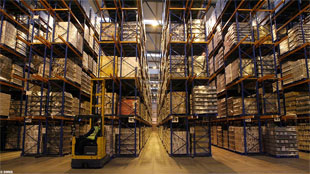Early in the virus pandemic that started in March, retail stores shelves soon emptied of a wide range of items, notably of course toilet paper and other paper products, but many other categories as well, from pasta and rice to cleaning wipes.
Supply Chain Digest Says...
|
 |
Grocers are now building inventories in some categories in terms of months of coverage, not weeks, to better prepare for this winter. |
 |
What do you say? |
| Click here to send us your comments |
|
 |
| Click here to see reader feedback |
|
There were a variety of factors. Suddenly locked down consumers were buying more safety-related products to protect against the virus, and many other consumer staples as product needs changed. Fear of later out-of-stocks led to binge buying, with rapidly empty shelves reinforcing the need to stock up, even as many retailers started limiting quantities of some products in short supply.
Meat supplies were way down for many weeks, as a number of processing plants were closed or had to limit production as the virus infected large numbers of their workers. Even makers of goods that could keep up with rising demand were faced with limitations at some retailers in their ability to deliver goods to stores, causing some manufacturers to find alternative paths, such as shipping directly to store, versus running all inventory through retailer distribution centers.
And with all that, retail and manufacturing supply chains that in the past two decades had become increasingly "lean" – keeping low inventories in the face of generally stable and predictable demand – resulting in little buffer inventory or spare manufacturing capacity to handle these new surges in demand.
As a result, many manufacturers were already at or near max production capacity before the crisis and simply incapable of responding with more supply, with capacity built to handle the previous and largely low growth demand for their products before the pandemic.
But now, with predictions that the number of infections are likely to spike again come late Fall and into winter, some manufacturers and retailers are – for now at least – willing to bulk inventories back up.
According to an article in the Wall Street Journal, retailer Southeastern Grocers placed orders for holiday turkeys and hams over the summer, months before it normally starts inventory planning.
In another example, Associated Food Stores has already started building "pandemic pallets" of products such as cleaning and sanitizing supplier so it always has some inventory in its warehouses.
"We will never again operate our business as unprepared for something like this,"” said one company executive.
The driver of all this: the chance to capture lost revenue that occurs when consumers encounter empty shelves.
(See More Below)
|
CATEGORY SPONSOR: SOFTEON |
|
|
| |
|
|
 Grocers are now building inventories in some categories in terms of months of coverage, not weeks, to better prepare for this winter. That often involves use of outside storage locations beyond their regular DC facilities. Grocers are now building inventories in some categories in terms of months of coverage, not weeks, to better prepare for this winter. That often involves use of outside storage locations beyond their regular DC facilities.
The Journal article says that Ahold Delhaize, parent company of the Giant Eagle and Food Lion grocery chains, already has its much of its holiday inventory in its warehouses. The company says it is storing 10% to 15% more inventory than it did before the pandemic to ensure it won't run out of popular items.
But there are no guarantees – and labor is a wild card. Retailers and manufacturers are worried they will be hit with outbreaks of workforce infections that cause associates miss work due to issues such as lack of child care.
Any reaction these changing inventory strategies? Let us know your thoughts at the Feedback section below.
|